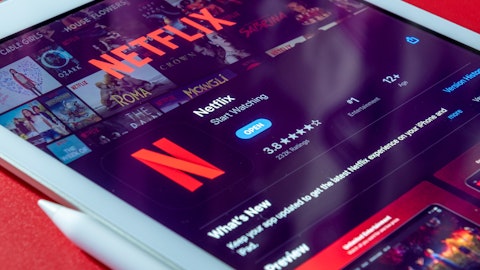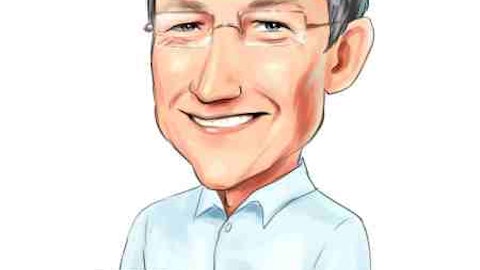Spence Neumann: Jessica, may I just €“ just one thing to add, I know but I just think the analogy is kind of fundamentally different. So with ESPN and the example you gave, that was a fundamental kind of shift in the industry from 100 plus million pay-TV connected homes to cord cutting that’s on a path down to mid to high single-digit reductions in that distribution platform each year and that’s moving in that direction. So it’s kind of a shrinking core distribution platform where you see in our earnings letter, the world is shifting from linear to streaming. Even in the largest €“ there is no country where streaming is more than 40% of share of TV time. And in many big countries, as you saw, it’s less than 5%. So, it’s our 5% €“ or it’s less than 5%, it’s less than 10%.
So there is an incredible runway still in the shift from linear to streaming. And so for us, it’s about growing into that shift and also obviously competing well and continuously innovating and improving. And what you saw or what we saw and felt when we had that decline in subscribers was really near-term limiters in growing into that big market, but the big market is still growing as opposed to fundamentally long-term limiters in that ESPN shift that you described.
Jessica Reif Ehrlich: Right. So let’s move on to some of the drivers of growth, both near and medium-term and start with advertising. So your advertising platform has been open only 2 months and you have amazingly given some money back to advertisers indicating in one way that demand is exceeding supply. The company is – you guys have consistently said you are going to crawl, walk and run. How is the (ph) going relative to your expectations?
Greg Peters: Yes. Like you say, it’s 2 months. And I think the hardest part is actually that first step when you are crawling, because you don’t really know what exactly to expect as you get it going. And now with 2 months, we are ridiculously early, but we have learned a bunch already, I would say. So just ticking through this, I mean, I’d say, first and foremost is that we were able to launch this very, very quickly. And the tech is all working. The product experience is good. And that’s really a testament to lots of hard work for both Microsoft and Netflix teams who worked very hard to make that happen and it’s really rewarding to that to see. The other, I’d say, pretty significantly fundamental thing is around engagement and we see that engagement from ads plans users is comparable to sort of similar users on our non-ads plan.
So that’s really a promising indication. It means we are delivering a solid experience and it’s better than we modeled and that’s a great sort of fundamental starting point for us to work with. Furthermore, now, we are seeing take rate and growth on that ads plan is solid. It’s great, because partly that take rate and that growth is due to incremental subscribers coming into the service, because we have a lower price point, that’s $6.99 in the U.S., €4.99 in Germany, just to give you two examples. And so that elasticity is a real €“ not only a benefit to sort of growing our ad scale and sustainability, but also to the general business. I expect to see that continue to actually grow over the year. That take rate fits sort of within the middle of our other plans, which is another really healthy sign.
It means that we’ve got a complementary set of offerings that are working to sort of satisfy different needs for different consumers at the right mix of features and price points. So that’s quite good. Another important one, I think, for the investor community because it came up a lot before we launched was plan switching. We aren’t seeing as expected much switching from high arm subscription plans like premium into our ads plan. So the unit economy remain very good as we modeled. So these are all really good initial sort of progress points, but I think it’s important to reiterate that as you mentioned, we’re crawling and we’d like to get to sort of move to the walking phase. We’ve got a lot to do to get there. So there is a bunch of technical improvements in terms of ad delivery validation, measurement.
We’ve got progress already on that, more to do in the next quarter or two. Targeting improvements, which will be better for consumers. More relevant advertising, better for advertisers in terms of more value delivered, a better set of offerings on products for advertisers to buy. We’ve got a long list of experience improvements that we know we can deliver that will deliver more value to both subscribers and advertisers. And there is just also some nuts and bolts stuff that we are learning and improving, just things like how do we do a better job with Microsoft at the ad sales and operations processes. There is so much that we need to do both companies need to do to better serve advertisers, serve an increasing number of advertisers and meet that demand.
So we’re just getting started. We’re constantly improving, and we see the trajectory ahead of us. And really, our aspirations are ultimately successively over a period of years to basically build, just like we have essentially in terms of the streaming experience, the best, most effective, highest quality premium connected TV ads experience as a win for consumers and advertisers and for us as a business.
Reed Hastings: Spence and Greg. Sorry, Jessica. Spence, maybe give a little context on Hulu, kind of what we know about Hulu’s advertising. They have got a 10-year head start. And sort of how many years will it take us to sort of pass them in all of these key dynamics?
Spence Neumann: Greg, do you want to go first or you want me?
Greg Peters: No, I’ll hand it over to you.
Spence Neumann: Alright. Let’s see. I mean Hulu is €“ yes, they have had a long start, they started in the ads business. They have €“ we would estimate, reason we obviously don’t know exactly, but roughly half of their membership is on the ad tier. It’s a multibillion-dollar business for them already, and that’s a domestic business, U.S. only. So lower reach, lower engagement than us. So I guess the short story there is we have given what we’ve seen and what Greg just outlined in terms of the engagement on our ad plan, the strength of the performance in terms of the monetization, kind of the unit economics and our ability to kind of scale in a way that is even better than the kind of comparable ad free plan, plus providing clearly choice that our members or consumers are seeking out because of the sign-up flow that we would expect to be as large or larger over time, certainly in just our U.S. market and more from there.
But it’s €“ I just want to emphasize, it’s a multiyear path. So we’re not going to be larger than Hulu in year 1. But hopefully, over the next several years, we can be at least as large, and we wouldn’t be getting into this business obviously, Reed, as you know, if it couldn’t be a meaningful portion of our business. So we’re over $30 billion of revenue, almost $32 billion of revenue. in 2022. And we wouldn’t get into a business like this if we didn’t believe it could be bigger than at least 10% of our revenue and hopefully much more over time in that mix as we grow. So that’s kind of how I see it without putting a specific guide on it.
Jessica Reif Erlich: You committed to an upfront market spot, taking CBS’s prior spot, CBS now Paramount spot, which really indicates your long-term advertising goals of being a major advertising platform. Given this is a prime spot on a critical week for advertisers in premium video. Like it’s just €“ it’s amazing how quickly you just took that lot away. What’s the run stage? And how would you and what’s the time frame to get there?




